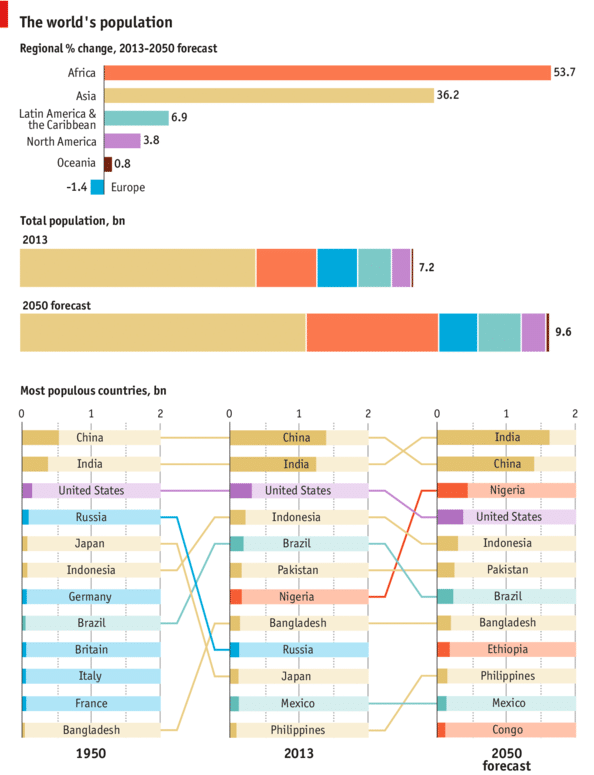A closer look at African student mobility
The UN predicts that the world’s population is going to increase to 9.6 billion in 2050 (from 7.2 billion today). Where will most of the growth come from? Africa and India. According to The Economist:
“More than half of the extra 2.4 billion people in 2050 will be African. India will swell to 1.6 billion people; it is on track to overtake China in 2028.”
For the moment, the total population of Africa exceeds one billion, representing just over 15% of the world’s total. The following graphic paints a compelling picture of the current composition of the world’s population, how it will change further through 2050, and the increasing share of the global population that Africa will gain during this period.

France still commands most mobile African students, but South Africa is gaining share
Of the 380,376 African students electing to study abroad in 2010 (representing roughly 10% of the world’s international students), 29.2% went to France, allowing France to retain its position as the #1 destination for African international students. However, South Africa, the #2 destination, has been gaining in market share relative to France since the last time the study was conducted. Its share of 15% of African students represents an increase of 28.8% since 2006, versus France’s decrease of 1% in that time. France is overwhelmingly the choice of Francophone African students (only 2.6% of the Africans studying in France are from English-speaking African countries), and most of the African students in France are from Morocco, the Maghreb, and Francophone Sub-Saharan countries. Meanwhile, South Africa is a popular choice for English-speaking African students from countries like Zimbabwe, Namibia, Botswana, and Lesotho. University World News summarises some of South Africa’s main benefits for African students:
“Advantages include less bureaucracy to obtain a visa than for European and American countries; it is less expensive than Europe; and it is ‘accessible, dynamic and stable.’ Its level of development, close to that of European countries, offers interesting professional prospects for students. Its public universities are of high quality. At the University of the Witwatersrand, which specialises in engineering and technologies, 20% of students are from another African country and they include a high proportion of Francophones. South Africa has also developed massive online open courses, or MOOCs, and distance education programmes represent 40% of education dispensed by its universities."University World News
also makes notes about the allure of Morocco (for French-speaking Africans) and Angola (for Portuguese speakers).
What about the rest of the world?
The United Kingdom and the United States come in third place as a study abroad destination for African students, commanding a 9.7% share each. However, the UK has gained in share (+19.3% since 2006) while the US has declined a little (-2.3%). Germany is in fourth place with 4.7%; it registered a decline in share since 2006 as well (-4.8%). Other contenders are emerging for African students from the Sub-Saharan African region (mostly English-speaking) in particular: Italy has increased its numbers of African students from this region by 54% since 2006, Canada has increased them by 42%, and Morocco by 50%.
Which African countries hold the largest proportions of students engaged in study abroad?
- Morocco: 42,800 international students (11.3%)
- Nigeria: 38,851 (10.2%)
- Algeria: 22,465 (5.9%)
- Zimbabwe: 19,658 (5.2%)
- Cameroon: 19, 506 (5.3%)
- Tunisia: 19,506 (5.1%)
Last year ICEF Monitor published a special feature on recruitment in South and Central Africa: please view it here.
Africa is on the rise for students around the world
The Campus France report found that various regional hubs in Africa are increasing in popularity to African students (i.e., instead of going to Western Europe or North America, African students are increasingly staying on the continent). There is also data showing that Africa is becoming more attractive to students elsewhere in the world. For example, IIE’s Open Doors Report on International Educational Exchange, supported by the US Department of State’s Bureau of Educational and Cultural Affairs, reports:
“US study abroad to Sub-Saharan Africa has also been growing in popularity over the past several years in line with the general trend of more study abroad to non-traditional destinations. The trend appears to have continued in 2010/11, with 36% of respondents reporting increases.”
Clearly, Africa is on the move - both in terms of its students’ mobility and in its reputation as a study abroad destination in its own right.
















